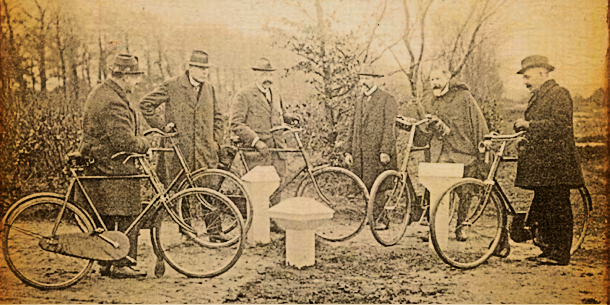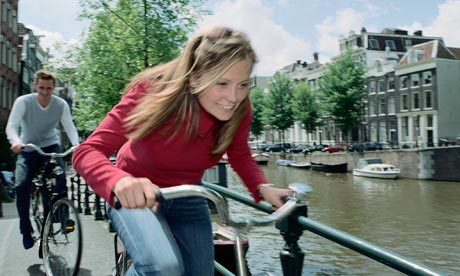Brompton's MD on how to create a Dutch-style cycling culture in the UK | Design Council
Some further comment:
So it's all about Dutch-style cycle paths?
Given that the Dutch have the highest cycling rate of any developed nation, and among the lowest road deaths (particularly of vulnerable people – children, the elderly, and cyclists),4 why wouldn’t we want to look to the Netherlands first as our inspiration? They have steadily grown a bicycle culture since the 1970s and as their approaches to infrastructure developed they made mistakes and learnt from them.
We do recognise that we’re a very different country from the Netherlands with different traffic laws and terrain and starting from a much lower cycling base. Not everything that works in the Netherlands will work here, but it would be foolish to ignore what the Dutch –and to a large extent the Danes - have done.
So where Dutch-style separated cycle paths would be the best approach to safe cycling on a particular route, that’s what we’d advocate. And where other approaches – shared space, home zones, reduced speed limits, on-road lanes, or contraflows – are appropriate we’d advocate those instead.
(To find out more about Dutch infrastructure, see our wiki page on the subject: http://www.cycling-embassy.org.uk/node/226 )
So it's all about Dutch-style cycle paths? | Cycling Embassy of Great Britain
Why is cycling popular in the Netherlands: infrastructure or 100+ years of history?
 Send to Kindle
Send to Kindle Imagine, if you will, War of the Worlds in reverse. Imagine not a destructive alien invasion, but a constructive one. Imagine giant space-ships sucking up all of the wonderful bike paths in the Netherlands and depositing them in the UK, creating ready-made bicycle infrastructure, separated from the road network, protected, connected. Once they’ve got used to having aliens as town planners, do you think car-mad Brits would become bike-mad? Would the instant installation of near-perfect infrastructure lead to an overnight explosion in bike use?
Imagine, if you will, War of the Worlds in reverse. Imagine not a destructive alien invasion, but a constructive one. Imagine giant space-ships sucking up all of the wonderful bike paths in the Netherlands and depositing them in the UK, creating ready-made bicycle infrastructure, separated from the road network, protected, connected. Once they’ve got used to having aliens as town planners, do you think car-mad Brits would become bike-mad? Would the instant installation of near-perfect infrastructure lead to an overnight explosion in bike use?
Yes, there would be an uptick but how much of an uptick? How much latent demand is there for cycling in the UK? I’d like to think lots, but I’m mostly an optimist. The pessimist side of me reckons that infrastructure provision, vital though that is, is not a magic pill. In the 1970s, the New Town of Stevenage had an excellent, inter-connected, Dutch-style cycleway network, designed by a cyclist (the network is still there, but was not improved or updated and Dutch infra *was* updated and improved, big-time), but cycle use did not explode there, far from it. It will take more than infrastructure to make Brits get back on their bikes.

Chicken and egg time: in the Netherlands, what came first, lots of people riding bicycles or infrastructure so lots of people would ride bicycles? The Netherlands has world class bicycle infrastructure, much of it built since the 1970s, but why was the modern stuff built? It was built partly because of effective tame-the-car campaigns putting people before motors, but it was also built – or, rather, extended and modernised – because so many people in the Netherlands already rode bicycles
There's more to 'going Dutch' than having a separate cycling lane
It has taken the Netherlands 25 years to build up its culture of respect among its road users, and the law plays a big part too

Cycling is a mainstream mode of transport in the Netherlands, and cyclists there therefore have more responsibilities. Photograph: Russell Underwood/Corbis
Conditions for cycling were ideal that balmy July day, on a quiet lane in Friesland, the Netherlands. For once I'd chosen the road rather than the cycle path, which was some way away down a dyke.
All of a sudden, the sedate caravanners passing me hit their horns in the kind of ear-splitting protest that would make a London minicab driver blush. Then the police arrived, and I had to give an Oscar-winning performance as dumb tourist to escape a fine.
It took time to sink in: the cycling facilities were so good that their use was obligatory, and enforced by the police. For a cyclist raised on the mixture of antagonism and neglect that still characterises London's cycling culture, it was a shock. And when members of the London Cycle Campaign recently voted for their 2012 mayoral election campaign to be"Go Dutch – clear space for cycling on London's main roads", it struck me that they will have to bring about an enormous shift in attitudes in a very short space of time.
The idealisation of Dutch cycling in the British cycling press omits to mention that being a respected, mainstream means of transport incurs responsibilities as well as offering rights. Laws about lights, bells, bikes on trains, as well as compulsory paths, are rigorously policed. Taking a bike on a train requires a €6 ticket in addition to the cyclist's fare – a significant cost for regular leisure riders.
None of this is unreasonable when the other side of the bargain is the combination of amenity and respect accorded to Dutch cyclists. But mutual respect takes a long time to build. A recent article (with an excellent video documentary) explains that it took the Netherlands about 25 years to get where it is today, from the depths of a child-killing car-centred policy in the 1970s.
There's more to 'going Dutch' than having a separate cycling lane | Bike blog | Environment | theguardian.com
There's an alternative to Brompton:
bikeandgo - YouTube
Dutch-style bike hire scheme now at more than 40 railway stations in England (+ video) | road.cc
.
.
.




No comments:
Post a Comment